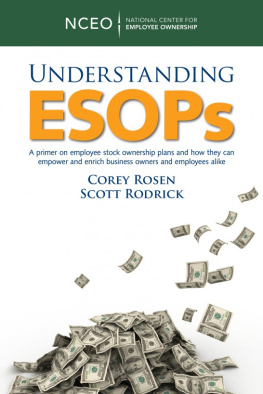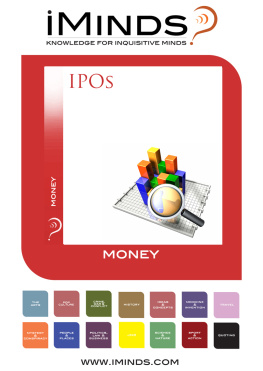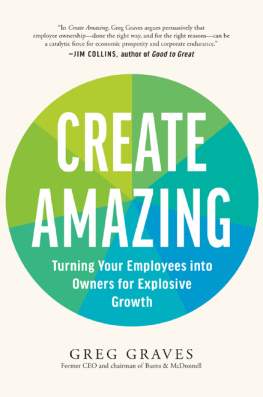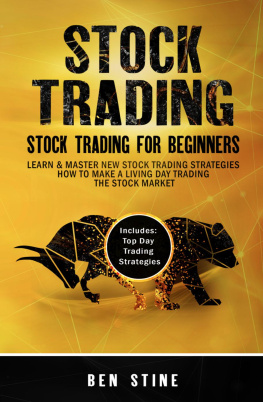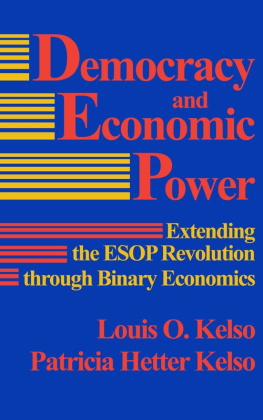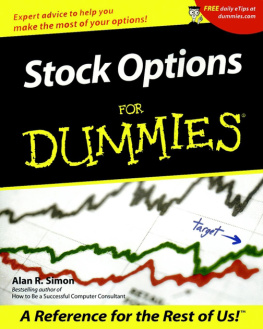UNDERSTANDING ESOPS
A Primer on Employee Stock OwnershipPlans
Corey Rosen
Scott Rodrick
The National Center for Employee Ownership(NCEO)
Oakland, California
Published by NCEO at Smashwords
This publication is designed toprovide accurate and authoritative information in regard to thesubject matter covered. It is sold with the understanding that thepublisher is not engaged in rendering legal, accounting, or otherprofessional service. If legal advice or other expert assistance isrequired, the services of a competent professional person should besought.
Legal, accounting, and other rulesaffecting business often change. Before making decisions based onthe information you find here or in any publication from anypublisher, you should ascertain what changes might have occurredand what changes might be forthcoming. The NCEOs Web site(including the members-only area) and newsletter for membersprovide regular updates on these changes. If you have any questionsor concerns about a particular issue, check with your professionaladvisor or, if you are an NCEO member, call or email us.
Understanding ESOPs
Corey Rosen and ScottRodrick
Copyright 2008, 2010 by TheNational Center for Employee Ownership. All rights reserved. Nopart of this book may be reproduced or transmitted in any form orby any means, electronic or mechanical, including photocopying,recording, or by any information storage and retrieval system,without prior written permission from the publisher.
First published 2008. Reprinted2010 with minor updates and additions.
ISBN: 978-1-932924-79-4
The National Center for EmployeeOwnership
1736 Franklin Street, 8thFloor
Oakland, CA 94612
(510) 208-1300
(510) 272-9510 (fax)
Email:customerservice@nceo.org
Web site: www.nceo.org
This ebook is licensed for yourpersonal enjoyment only. This ebook may not be resold or given awayto other people. If you would like to share this book with anotherperson, please purchase an additional copy for each recipient. Ifyoure reading this book and did not purchase it, or it was notpurchased for your use only, then please return to Smashwords.comand purchase your own copy. Thank you for respecting the hard workof these authors.
Contents
Corey Rosen
Scott Rodrick
Corey Rosen
Corey Rosen
Corey Rosen
Corey Rosen
Scott Rodrick
Corey Rosen
Corey Rosen
When the National Center for EmployeeOwnership (NCEO) was founded in 1981, employee ownership was arelatively unknown and somewhat suspect notion. Today, we estimatethat 25 to 30 million Americans own stock in their companiesthrough one kind of plan or another. Over 13 million of theseemployees are participants in an employee stock ownership plan(ESOP), the subject of this book.
Understanding ESOPs grew out of TheESOP Reader, NCEOs most venerable publication and one thatgoes back to the NCEOs founding in 1981. In its variousincarnations, the Reader served as a nontechnical referenceon the subject for decades. Nowadays, we at the NCEO provide a widevariety of ESOP publications (and other information resources,online and offline), and our aim in producing this new book is topresent the topic in a more streamlined and efficient way so thatthe reader gets the depth he or she needs on certain topics, whileother matters that need not be discussed in an introductory workare quickly passed over.
The first chapter of this book presents anoverview of what ESOPs are, how they work, and what they are usedfor. Subsequent chapters delve into important topics that deservemore detailed treatment. Finally, the last chapter discusses how anESOP can improve corporate performance and how that is linked tocreating an ownership culture.
This book is for the reader who desires acomprehensive overview of the subject. There are many other issues,however, and beyond that there are other equity plans that can beused in addition to or instead of an ESOP. For more information ontechnical matters, communicating to employees, creating anownership culture, and using other equity plans, see our books andinformational resources.
Chapter 1
Corey Rosen
An employee stock ownership plan (ESOP) is aspecific way to share ownership with employees that can provide taxbenefits to the company, to sellers of stock to an ESOP, and toemployees. Given statutory authority in 1974 under the EmployeeRetirement Income Security Act (ERISA), ESOPs are governed by manyof the same rules that cover 401(k) plans, deferred profit sharingplans, pension plans, and other retirement plans. Unlike theseother plans, however, only ESOPs are designed to invest primarilyin the stock of the employer, and only ESOPs can borrow money.ESOPs should not be confused with employee stock option plans,which are covered by a very different set of rules. Nor are ESOPsto be confused with stock purchase plans. In fact, ESOPs are almostalways funded by the company, not by employeecontributions.
The basic concept of an ESOP is simple. Acompany sets up a trust fund to acquire and hold company stock. Thecompany can contribute shares directly, contribute cash to buyshares, or have the trust borrow money to buy stock, with thecompany repaying the loan through contributions to the plan. Thecompany also can contribute cash to the trust or pay dividends ordistributions on shares held by the trust. The shares, and anyother contributions, are allocated to employee accounts based on anequitable formula. Companies cannot, however, make allocationsbased on discretionary approaches, such as performance assessments.Employees acquire vesting rights to these allocations over time.After employees terminate, their account balances are distributedto them, with some exceptions described below. The plan is governedby a trustee, usually appointed by the companys board ofdirectors; the minimum allowable governance rights for employeesare very limited, although some companies provide more extensiveones. Within broad limits, contributions to the plan aretax-deductible. Employees pay no tax on what is in their accountsuntil they actually receive a distribution, and even then they canroll the distribution into an IRA or other retirement plan. Somesellers to an ESOP can defer capital gains taxes on the sale, andthe profits attributable to the ESOP in an S corporation are nottaxable at the federal and, usually, state levels.
ESOPs are used for many reasons. The mostcommon is to provide a vehicle for the company to fund the purchaseof an owners shares on a pretax basis, but ESOPs are also usedsimply to provide an additional benefit, to acquire othercompanies, to spin off subsidiaries or divisions, and to financecapital growth. For all their many benefits, ESOPs are not rightfor every company. They are more complex than other retirementplans, they do not allow as much flexibility as less tax-favoredapproaches to sharing ownership, and they usually are a poor fitfor extremely small companies (typically under 10 to 15 employees)and companies that either are not or do not soon anticipate makinga profit.
This book is written for people thinking aboutESOPs. It walks you through the various rules and applications,discusses what to think about in setting up a plan, and providesguidance on how to make the plan work well for your company. As anintroduction to the topic, it is not meant to be comprehensive. TheNCEO does, however, have a variety of detailed publications on ESOPapplications, tax issues, administrative practices, and ownershipculture. For a list, go to our Web site at www.nceo.org.
This chapter provides a broad overview ofESOPs. Subsequent chapters look at ESOP applications and rules inmore detail, while a final chapter discusses what may be the mostimportant potential benefit of an ESOP, namely the potential tocreate a more engaged and productive culture.
Next page
